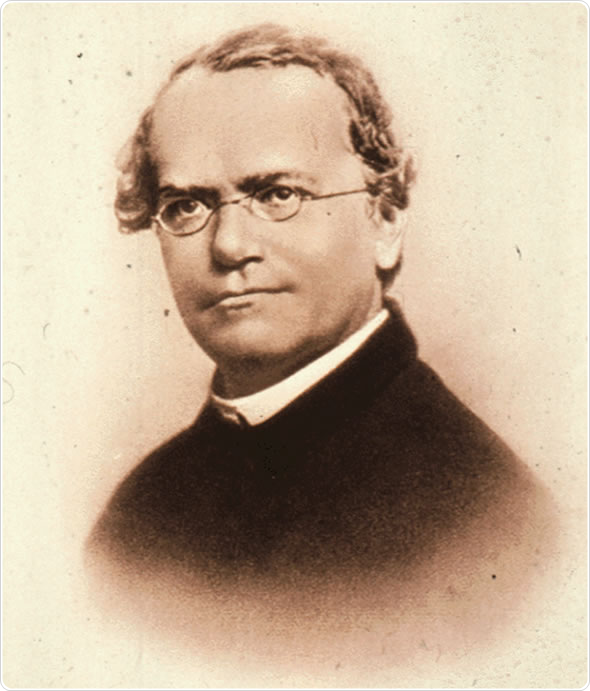History of DNA (Deoxyribo Nucleic Acid) research, Read This
Minggu, 15 Januari 2023
History of DNA (Deoxyribo Nucleic Acid) research, Read This
The history of genetic investigation begins with Gregor Mendel "Father of genetics". He had already conducted experiments with plants in 1857 which led to increased interest in genetic research.

Mendel
Mendel who became a monk of the Roman Catholic Church in 1843, studied at the University of Vienna where he studied mathematics, and later carried out many scientific experiments.
The experiment involved growing pea plants for 8 years. He was forced to give up the experiment when he became abbot at the monastery. He died in 1884, but his experiments still form the basis of genetics and provide a fair idea of inheritance.
Friedrich Miescher and Richard Altmann
Friedrich Miescher (1844-1895) discovered a substance which he called "nuclein" in 1869. Then he isolated a pure sample of the substance now known as DNA from salmon sperm, and in 1889 his student, Richard Altmann, named it "nucleic acid". ". This substance is found only in chromosomes.
Frederick Griffith
Frederick Griffith, a scientist, worked on a project in 1928 that formed the basis that DNA was an inherited molecule. Griffith's experiments involved rats and two types of pneumonia—one was virulent and another was non-virulent. He injected virulent pneumonia into the mouse and the mouse died. Next he injected pneumonia-free virulence into the surviving mice and rats.
After this, he heats up the virulent disease to kill it and then injects it into the mouse. This time the animals survived as predicted. Finally he injected non-virulent pneumonia and virulent pneumonia that had been heated and killed, into mice. This time the mouse died.
Griffith speculated that killing virulent bacteria passes on its non-virulent characteristics to make them virulent. He believes these characteristics are in molecular inheritance. This passing on the inherited molecule is what is called a transformation.
Oswald Avery
Oswald Avery continued with Griffith's experiments around a decade later to see what molecular inheritance was. In these experiments, he destroyed lipids, ribonucleic acids, carbohydrates, and pneumonia virulent proteins. The transformation still happened after this. Furthermore it destroys Deoxyribonucleic Acid. The transformation didn't happen. He had found the foundation of the inheritance.
Phoebus Levene
In 1929 Phoebus Levene at the Rockefeller Institute identified the components that make up the DNA molecule. The components are:
a. Four bases
Adenine (A)
Cytosine (C)
Guanine (G)
Thymine (T)
b. Sugar
c. Phosphate
He showed that the components of DNA are linked in a phosphate-sugar-base sequence. He said that each unit is a nucleotide and stated that the DNA molecule consists of a series of nucleotide units linked together by means of phosphate groups. She
suggesting that these form the 'backbone' of the molecule.
However, Levene thinks the short, basic chains are repeated in the same fixed order. It was Torbjorn Caspersson and Einar Hammersten who showed that DNA is a polymer.
Erwin Chargaff and Chargaff's rules
To better understand the DNA molecule, scientists try to build models to understand how it works and what it does. In 1940 another scientist named Erwin Chargaff discovered patterns in the amounts of four bases: adenine, guanine, cytosine, and thymine.
He took DNA samples from different cells and found that the amount of adenine was almost equal to the amount of thymine, and that the amount of guanine was almost equal to the amount of cytosine. Thus you could say: A = T, and G = C. This discovery later became Chargaff's rule.
Rosalind Franklin and Maurice Wilkins
Then two researchers Rosalind Franklin and Maurice Wilkins tried to make crystals of DNA molecules. They want to take X ray pictures of DNA to understand how DNA works. These two scientists were successful and obtained x-ray patterns.
Patterns that appear to contain lengths, such as those in steps between to adjoining strands. They discovered that DNA has a helix shape.
Watson and Crick
In 1953, two scientists, James d. Watson and Francis Crick, trying to put together a DNA model. They took a look at Franklin and Wilkin' s X-ray pictures and made a model of them.
They created a model that hasn't changed much since then. Their model shows a double helix with a few lengths connecting the two strands. These are the nucleotide bases.
They also found that if they paired thymine with adenine and guanine with cytosine the DNA would look uniform. This pairing is also according to Chargaff's rules.
They also found that hydrogen bonds can form between two base pairs. In addition, each side is a complete complement to the other.
Alec Jeffreys
DNA profiling was developed several years later in 1984 by British geneticist Alec Jeffreys of the University of Leicester, and was first used to convict Colin Pitchfork in 1988 in the Enderby murder case in Leicestershire, England. So begins the journey of DNA research.
Review by April Cashin-Garbutt, BA Hons (Cantab)
Source
